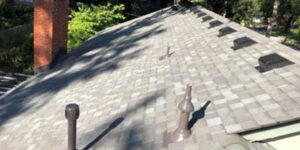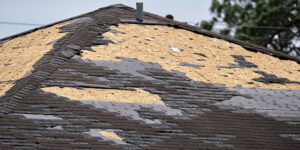The short answer is “That depends.” Insurance companies will generally pay for a roof if wind or hail has affected it. Let’s take a look at both.
Hail —Hail events in the U.S. can range in the thousands every year. Some regions have on average, more hailstorms than others. Hailstorms can happen anywhere if conditions are right. When hail hits a shingle, 2 things can happen: If big enough, it can break the fiberglass backing of a shingle, or if the hail is smaller, it can knock off or loosen the granules, the tiny rocks that cover the surface of the shingle. Once the latter happens, a shingle can start to degrade more quickly than normal and warrant replacement. In both cases, insurance will generally pay for the roof if 8 to 10 hail hits per slope are present.
Wind —Unlike hail, the wind blows everywhere at some point. Wind damage is the easiest form of storm damage to see since sometimes the shingles blow off into the yard or driveway. However, wind damage goes beyond blow-offs. Sometimes wind creates a diagonal-looking pattern on the roof. That’s a sign that the wind has started to separate the seals on the shingles. Seal, or mastic separation, is considered wind damage. A roofing company like Green Country Roofing can help determine how much wind damage is present on your roof beyond just blown-off shingles.
Now sometimes a roof has an extensive combination of wind and hail damage or even just one or the other so replacement is warranted. In other instances, the damage might be light or simply not enough to require replacement. For instance, you might have 2 or 3 missing shingles on one slope of your roof. Normally, a repair would suffice. However, 3 considerations would still warrant replacement even with minimal damage such as this:
- The shingles are non-repairable.
- The shingles are no longer made.
- A uniform appearance cannot be achieved.
Let’s look at each consideration a little more closely:
- If a repair is warranted or suggested, the repairability of a shingle needs to be tested. As shingles get older, sometimes they will break or crack when lifted. This would mean that a roof is non-repairable, and thus warrants replacement.
- Sometimes shingle manufacturers stop producing a shingle style or color. If a repair is needed on a slightly storm-damaged roof comprised of a shingle that is no longer manufactured, a full roof replacement would be warranted.
- If the recommended repair were to be completed, would a uniform look on the roof be attained? For instance, if a roof is 20 years old and new shingles were installed in several spots, the roof could end up looking like a checkerboard.
Consequently, this could warrant replacement as well.
The biggest myth that homeowners have regarding insurance companies and roof replacement is that their roof is too old for the insurance company to replace it. There is no such thing as a roof that is too old. The age of the roof only increases the likelihood that the roof cannot be repaired, and the shingles are no longer made. These factors almost guarantee roof replacement would be warranted if storm damage is present.
In the end, we hope this post has helped you out. If your roof meets any of these criteria, roof replacement should be covered by your insurance company. If you have any questions about your roof and replacement, get in touch with us, and we will respond promptly.




